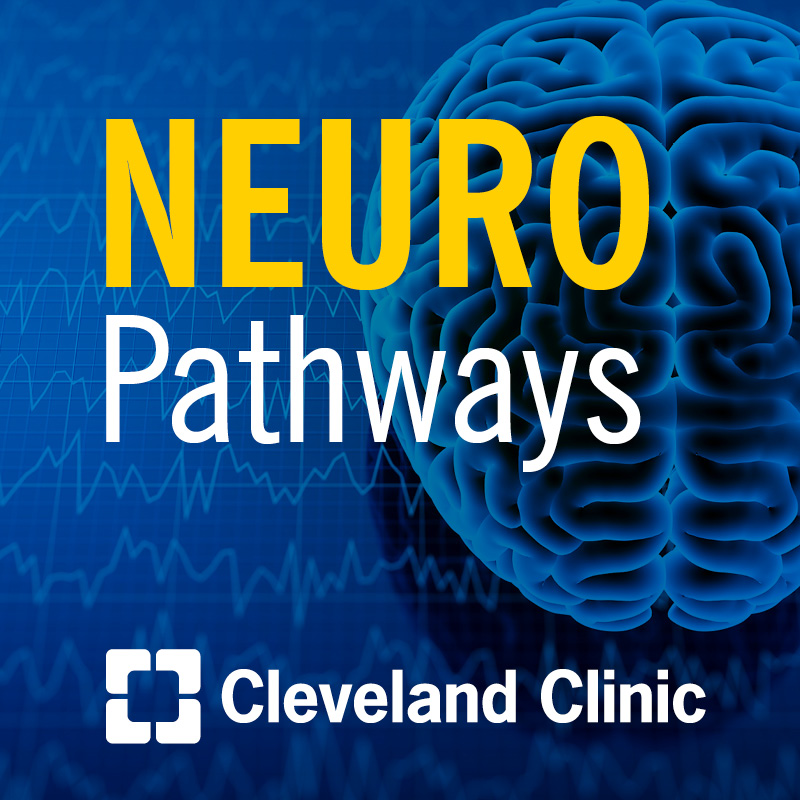Insights into Advanced Surgical Techniques for Neuroblastoma

Gloria Gonzalez, MD, Pediatric Surgeon and Director of Pediatric Surgical Oncology, joins the Cancer Advances podcast to provide her insights on advanced surgical techniques for neuroblastoma. Listen as Dr. Gonzalez explains the complexities of neuroblastoma, the use of 3D printing in preoperative planning and 3D image-guided surgery, and the emerging role of fluorescent-guided surgery.
Subscribe: Apple Podcasts | Podcast Addict | Buzzsprout | Spotify
Insights into Advanced Surgical Techniques for Neuroblastoma
Podcast Transcript
Dale Shepard, MD, PhD: Cancer Advances, a Cleveland Clinic podcast for medical professionals exploring the latest innovative research and clinical advances in the field of oncology.
Thank you for joining us for another episode of Cancer Advances. I'm your host, Dr. Dale Shepard, a Medical Oncologist, Director of International Programs for the Cancer Institute, and Co-Director of the Sarcoma Program here at Cleveland Clinic.
Today I'm happy to be joined by Dr. Gloria Gonzalez, a Pediatric Surgeon and Co-Director of Pediatric Cancer Programs here at Cleveland Clinic. She is here today to talk about insights into advanced surgical techniques for neuroblastoma, so welcome.
Gloria Gonzalez, MD: Thank you very much.
Dale Shepard, MD, PhD: So as I understand, you have not been here at the clinic long, so what do you do here and what are your goals kind of while you're here?
Gloria Gonzalez, MD: So I'm a pediatric surgeon. I come from Chile, and here I want to develop a little more elaborated cancer program and try to work with the pediatric oncologists, radiologists, et cetera, to have a really good multidisciplinary team to treat pediatric cancer of course, and mostly related with surgery.
Dale Shepard, MD, PhD: Okay. And we're going to talk today primarily about neuroblastoma. So a lot of different people listening in, different backgrounds. Tell us a little bit about neuroblastoma. What is that?
Gloria Gonzalez, MD: So yeah, neuroblastoma is one of the most frequent cancer in children, actually it's the most common in the abdomen. So neuroblastoma is a cancer that primarily affects young children, arises from early nerve cells, that they're located in the sympathetic nerve system. And that means it can arise from the adrenal glands or all the sympathetic chain that we have from the neck to the pelvis.
Dale Shepard, MD, PhD: Okay. And about how many cases of neuroblastoma are there a year?
Gloria Gonzalez, MD: It depends of course in the population, but it's like 15% of our cases, so it is pretty big.
Dale Shepard, MD, PhD: So it's pretty common?
Gloria Gonzalez, MD: Yes. And it characterized because it's really heterogeneous. It depends in the biology of the tumor. You can have a really good tumor, for example, in newborn that they're born with this disease. It goes away by itself. But in toddlers, like a little bigger kids, they can be really malignant and have metastasis and everything.
Dale Shepard, MD, PhD: Okay. So you just pointed out there's a wide range, but I guess as a surgeon, what's sort of the typical approach if someone comes in to see you, how do we typically treat them at this point?
Gloria Gonzalez, MD: Like I said before, it depends in the age. So if you have a congenital neuroblastoma, the main approach right now is to observe. And so it's an active observation with images and labs and everything to be sure this will shrink by itself. So we can follow the patients really close by. And if they shrink, it's treated.
But if you have a toddler with this disease, first we see the images, that's the first thing, and we need to know if it's resectable or not. So if we surgeons think we can resect it and we can take it out, that's the main aim of the treatment at that point. And many of the patients might need chemotherapy afterwards.
But if you see one that you have a really bad disease in the abdomen and located in case in the vessels and nerves and it has metastasis, you will need chemotherapy first to shrink it. After that comes the surgery, and the patient can have radiation therapy and bone marrow transplant to be treated.
Dale Shepard, MD, PhD: When we think about from the surgical side, is this like most tumors where complete resection correlates with survival?
Gloria Gonzalez, MD: Yes, but in the one that I told you before, the one that are really bad, I mean in case in the vases, the vessels, what we achieve is try to do a near total resection. So that means try to remove almost all the tumor to achieve a better response.
Dale Shepard, MD, PhD: And then that's where you have the radiation and chemo and things?
Gloria Gonzalez, MD: Exactly.
Dale Shepard, MD, PhD: So what are some of the biggest challenges at this point in terms of surgery in these patients?
Gloria Gonzalez, MD: Problem with neuroblastoma, they usually occur in around the vessels and around the aorta, cava, the renal pedicle, because it's in all the sympathetic chain and also it affects the lymph nodes all around the abdomen or the mediastinum.
So what we usually have is a patient that doesn't have just one organ affected. It is encasing everything. And that's the main challenge, because you have to keep all the things working of course, so we have to try to take it out without doing any damage.
Dale Shepard, MD, PhD: And I guess just roundabout, just how often can you actually remove all of it with our current techniques?
Gloria Gonzalez, MD: With our current techniques, I think we can have a 95% of the patients with a really good surgery. That means at least 98%. Some says over 90% of the tumor resected.
Dale Shepard, MD, PhD: So let's talk about some different ways to consider treatments, and I guess 3D image-guided surgery is one thing. Tell us a little bit, what is that?
Gloria Gonzalez, MD: So 3D images is a, you know the normal MRI CT scan? They give us a two-dimensions or two-planar vision. And with some softwares that we have right now, what we can do is do a three-dimensional image, so we can imagine how it is in real life, the tumor.
So it's pretty neat. So you take the MRI, you take the CT scan and the software, and it allows us to have a really good view of what we're going to encounter in the surgery itself.
Dale Shepard, MD, PhD: And does this also extend into 3D printing, for instance, to come up with a model so you know what you're going to be dealing with once you're in there?
Gloria Gonzalez, MD: Yes, it's pretty neat actually.
Dale Shepard, MD, PhD: Yeah.
Gloria Gonzalez, MD: So we started with at least liver, kidneys, their organs that are affected, and we have a 3D printing, and now the printers are so good that we have different materials.
So first we try to plan the surgery in the software. So this is combined. So we sit with the technicians, with the imaging technicians to see where is the tumor, plan the surgery, where to cut, how to cut away from the vessels and the nerves. And if we have to take out, we know already, so we have everything planned.
And after that you can have the 3D printing. And with different materials, I can do surgery ahead of the surgery. I mean beforehand.
Dale Shepard, MD, PhD: Yeah. Have a test run.
Gloria Gonzalez, MD: So it is pretty nice to do it, yes.
Dale Shepard, MD, PhD: When we think about the involvement of so many different structures and things, what kind of team is usually involved in terms of specialties?
Gloria Gonzalez, MD:
Wow, many. I mean, when we have a neuroblastoma, here in Cleveland Clinic we have a multidisciplinary team meeting. And in those, all of us are involved because it's not just the surgery, it's not just the how do we take the tumor, it's how to treat the patients and when to treat it, like when is better to receive the chemotherapy, radiation, bone marrow transplant, et cetera?
So we sit together like pediatric oncologists, radiologists, radio oncologists, surgeons, psychologists, psychiatrists, and the nurse practitioner. So there's maybe 15 different teams working together to treat a patient and try to give them personalized treatment because all these tumors are different. So because of the heterogeneity that they have, you have so big a range of tumors that we have to sit together to think in one patient.
Dale Shepard, MD, PhD: As we think about incorporating this 3D imaging, 3D printing sort of pre-planning, been the biggest impact? Maybe saving structures that you may have had to take out before, recoveries. What are some of the benefits that you've seen?
Gloria Gonzalez, MD: We're still finding data to know the numbers, but I have been doing this in liver and kidneys, and now we're starting in neuroblastoma more and more. But definitely it lowers the rate of blood loss during the surgery. Try to keep some structures.
If you're in the surgery, you think it's not achievable, but now we have a really plan ahead to know what we are going to be capable of. So that means it increased the recovery time. And sometimes we can do minimally-invasive surgery to remove a tumor that at the beginning we were doing open because it looks bad, but now we have much more information, so decreases the complications.
And also, it allows us to remove more negative margins, and that means increased survival. That is the most important thing of course at the end.
Dale Shepard, MD, PhD: Yeah. A lot of technology, a lot of people involved. Neuroblastomas in general, are these usually treated at larger centers?
Gloria Gonzalez, MD: Yes, yeah, it should be treated in larger centers.
Dale Shepard, MD, PhD: So I guess that's kind of a if people run across one, get them to a place where they have the expertise.
Gloria Gonzalez, MD: Yes, and all the team available to do it. And actually, I think all the pediatric tumors kind of are in that category because, and that's good of course, oncology patients, they're not much. If you compare with adults, I'm pretty sure almost all of us will have a cancer at some point. In children it's not that way. So it is an infrequent disease, so it has to be treated in a place that you have the experience.
Dale Shepard, MD, PhD: Yeah, makes sense. Fluorescent-guided surgery, change gears a little bit, what exactly is that?
Gloria Gonzalez, MD: This is a really, again, a really good tool for us and has been used for different things. So we started with ICG, and ICG is like an indocyanine ingredient, that's what it mean. It's a fluorescence dye that we can see during the surgery with some special cameras.
So ICG has been used for long, long time, first for the ophthalmologist to see the vasculature of the eyes, but now it has been used in many settings and we are using it in here for example in cholecystectomies to try to avoid damage the common bile duct for example.
So it means can be so simple that that surgery like being cholecystectomy, but we are using it for different things to see the vessels during the surgery. But in tumor, like in oncology surgery, we're trying to do more and more research to try to put together these fluorescence molecules with some antibodies that they're expressed just in the tumors.
So you can see the tumor during the surgery. So it allows you to know what is the tumor more alive where you are in the surgery, what is treated tumor already, so is necrosis, so we have a better surgery.
Dale Shepard, MD, PhD: So it might help with margins because you kind of know.
Gloria Gonzalez, MD: Definitely.
Dale Shepard, MD, PhD: Yeah.
Gloria Gonzalez, MD: And of course if you put some other dyes and you combine it, you can see the vessels during the surgery, and so you're looking at everything. So in normal life, we see all of range of pink and browns and yellow things in surgery, and right now we are looking at colors. And color means a live tumor. So it's really good.
Dale Shepard, MD, PhD: That must take a little getting used to, right? Because you're used to historically looking at pale shades and then now you see colors.
Gloria Gonzalez, MD: Yes, yes, it's true. But actually, it's so a good tool that you learn right away.
Dale Shepard, MD, PhD: Is there work being done to sort of develop even more specific dyes for different types of tumors and things and?
Gloria Gonzalez, MD: For example, in neuroblastoma is one of the things that they have been done, there is a particular, it's an antigen found in neuroblastoma cells, is GD2. If you have an agent, like is an antibody, against these GD2 molecules, you can put together that antibody with fluorescence.
So this has been done in laboratory and has been a really good tool to try to learn about these fluorescence with a specific kind of molecules and target it to different tumors.
So right now what we are trying to do in these settings is try to see if the activity of the fluorescence is related with necrosis or how much alive the tumor is. And we know in neuroblastomas there is a heterogenicity of the cells, but all of those has this GD2. So it's really good. It's really good.
Dale Shepard, MD, PhD: Are there similar sort of tracers, markers being used-
Gloria Gonzalez, MD: In different tumors?
Dale Shepard, MD, PhD: In different tumors, but also from an imaging standpoint to make sure the extent of tumor, whether there's metastatic disease and things before surgery?
Gloria Gonzalez, MD: Yeah. Yes. Actually, if you combine these antibodies with MRI imaging and with CT, and it's like you are doing with PET-CT. In PET-CTs that has been used for a long time, you mark glucose and you see the activity, the glucose intake in the tumor, I mean in the tumor cells. So it shows more activity in the malignant tumors because they're really avid for glucose.
So you can imagine this tumor that has a really specific molecule and it will be targeted with fluorescence and some molecules that you can see in PET-CT, you can do both or MRI for example exactly the same. So you can see what, again, what is alive in images, and of course doing a really good view of how is the tumor behaving after treatment.
Dale Shepard, MD, PhD: And so when we think about these techniques we've talked about, these really could apply to a primary resection, but also for recurrence?
Gloria Gonzalez, MD: Yes, and for metastasis.
Dale Shepard, MD, PhD: Yeah.
Gloria Gonzalez, MD: So many times when we do surgery, we have a scar tissue. And in kids, they're growing, so they change all the time. So sometimes we have some like a little lump, and we don't know if that, for example, lymph node or that little nodular thing is a scar, is a lymph node, is a normal lymph node. Again, kids has really enlarged lymph nodes, and sometimes they're not bad, they're not malignant, so with those images or these images that I'm talking, you can see what is tumor, what is not.
Dale Shepard, MD, PhD: We've been talking about removing tumors. Let's change gears really quickly and talk about putting something in, and that would be fibrin gels. Tell me about fibrin gels, what they are, how we use those.
Gloria Gonzalez, MD: So the fibrin gels is like a mesh, but actually it's a gel of course. It is done with different molecules that keep some agents in place. And it's like a matrix with all the molecules that the tumor cells, they're really happy with. So oxygen, CO2 and some different elements that you have.
But if you put in that fibrin gel, you put some antitumoral agents, these agents can be in that place for longer time. So that means the cells that they're in in the place kind of take these molecules with the antitumoral agent and they kill itself.
So it allows us to have a better local control with minimally disease or minimally all this microscopic tumor that we cannot see during the surgery. So again, this is really good.
And there has been some new developments in neuroblastoma with some molecules, and they are doing chemotherapy agents. That means, for example, doxorubicin that is really good, and they are being applied like a fibrin glue in the field after the surgery and has been really good.
Dale Shepard, MD, PhD: In that way you can treat the tumor itself without all the side effects to the patient.
Gloria Gonzalez, MD: Yes. I don't know if we are in the area where you can avoid the IV chemotherapy. Of course IV chemotherapy has really good effects in malignant tumors, but as you saying, there are really bad effects also. But I think it will be kind of like a combined maneuver. So try to give IV chemo for all the disease that is going around our cells, like the metastatic cells, and these will help with local control.
Dale Shepard, MD, PhD: When we think about these are great techniques, what are you looking forward to? Is there anything that looks particularly promising that's going to be the next greatest thing?
Gloria Gonzalez, MD: I think it's combining everything, and try to get access like we do with surgery. At the beginning, not many surgeons were allowed to do the surgeries. After that came the minimally-invasive surgery with laparoscope. Now we have better instruments, smaller instruments for childs. After that we have robotic surgery that allows us to get in different and in smaller places with better results. So now combining all these things, it is really good.
For example, we have access to have the MRI images and the 3D planning during the surgery and combine this with the laparoscopic view in robotic. So we are looking inside the organ, combining all those things.
And so you can imagine combining these 3D planning with molecules that we can see the tumor, better instruments, and all these together, and after that, targeted the tumor with specific molecules, I think we are going to do great things in the future.
Dale Shepard, MD, PhD: That's fantastic.
Gloria Gonzalez, MD: Yeah.
Dale Shepard, MD, PhD: So.
Gloria Gonzalez, MD: So we're really happy with it.
Dale Shepard, MD, PhD: Yeah. It looks like a promising future, so.
Gloria Gonzalez, MD: It is.
Dale Shepard, MD, PhD: Appreciate you coming by and sharing your insights.
Gloria Gonzalez, MD: Thank you.
Dale Shepard, MD, PhD: To make a direct online referral to our Cancer Institute, complete our online cancer patient referral form by visiting clevelandclinic.org/cancerpatientreferrals. You will receive confirmation once the appointment is scheduled.
This concludes this episode of Cancer Advances. For more podcast episodes, visit our website, clevelandclinic.org/canceradvancespodcast. Subscribe on Apple Podcasts, Spotify, or wherever you listen to podcasts.
Thank you for listening. Please join us again soon.


